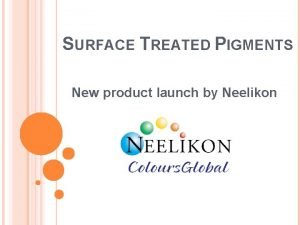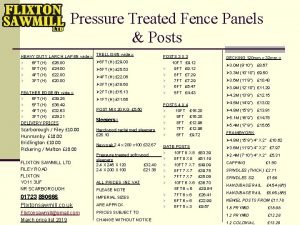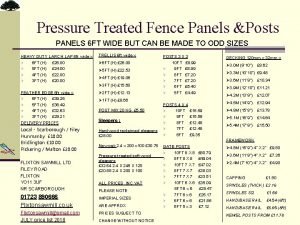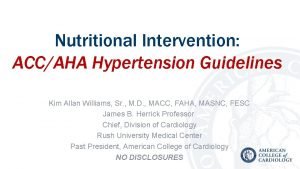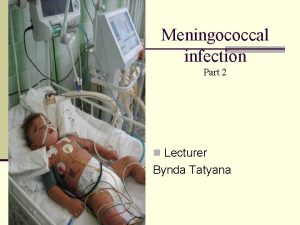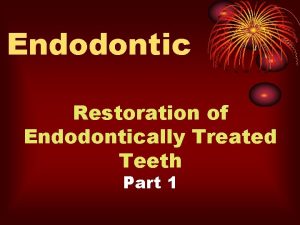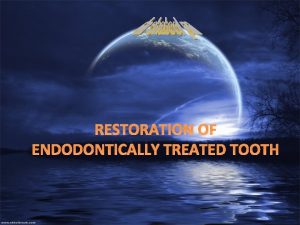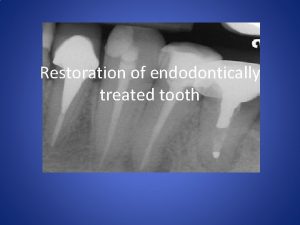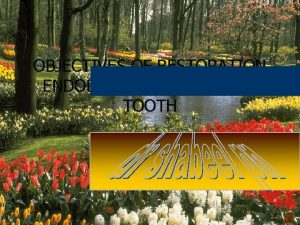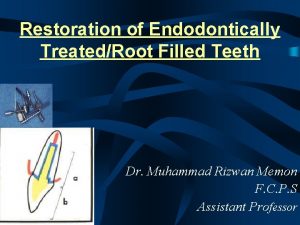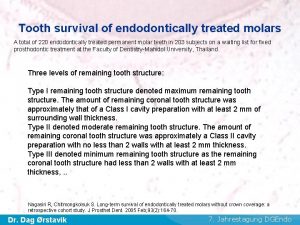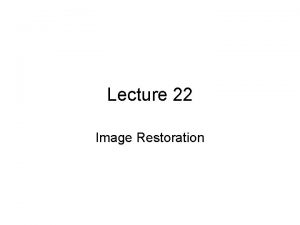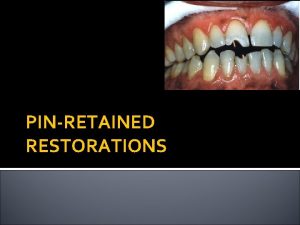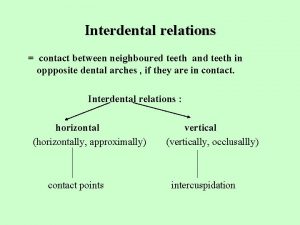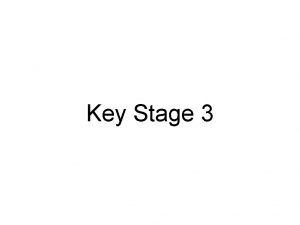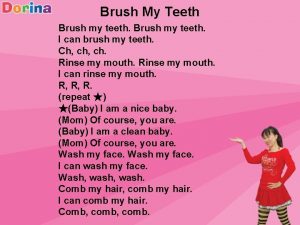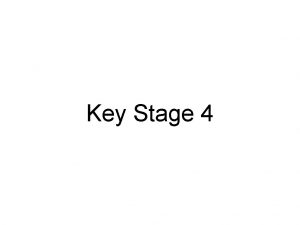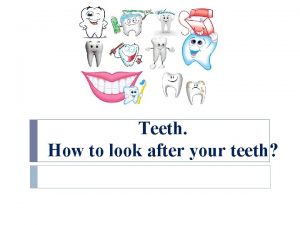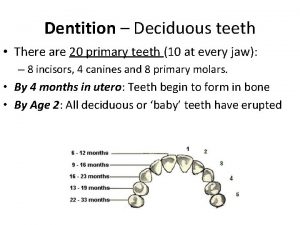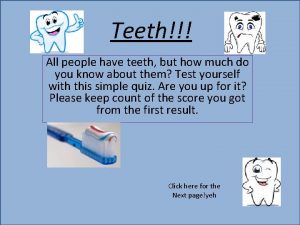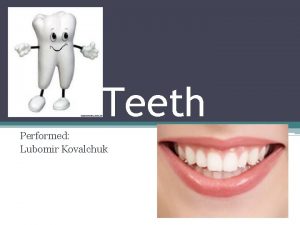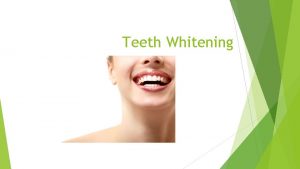Restoration of endodontically treated teeth Introduction The Endodontically













































- Slides: 45

Restoration of endodontically treated teeth.

Introduction. The Endodontically treated teeth are more susceptible to fracture than unrestored vital teeth and also lack a lifelike translucency, thus requiring a specialized restorative treatment.

Addressing the problem ? ? ? “LOSS OF THE TOOTH STRUCTURE” In terms of: 1. Retentive features available 2. Liability to fracture

Therapeutic goals: 1. Improving the retentive quality 2. Improving the fracture resistance

• Negative influence of RCT on remaining sound tooth structure: • Architectural Changes. • Reduction in the dentin toughness. • Moisture loss. • Biomechanical Changes

1. Architectural Changes dome shaped roof of pulp chamber Loss of tooth Structural integrity (decay, dental procedures and endodontic therapy ) Fracture resistance of the tooth decreases Recent studies have concluded that: • access cavity preparation are associated with 5% reduction in tooth stiffness • Loss of MR is associated with 46% reduction in tooth stiffness • Loss of 2 MR is associated with 63% reduction in tooth stiffness Circumferential loss in tooth structure is liabiity to #.

• Moisture loss: It has a minimal effect on fracture liability. • Reduction in the dentin toughness: It has an insignificant effect on fracture liability.

Biomechanical Changes: Proprioceptive feedback mechanism is lost after endodontic treatment. This might subject endodontically treated tooth to greater loads than a normal intact tooth. Tidmarish showed that a normal tooth is hollow laminated structure which deforms under load but complete elastic recovery occurs after physiological loading.

Loss of the coronal tooth structure is the main cause of the loss of the strength

Pre treatment considerations: 1. Restorative considerations. 2. Periodontal evaluation. 3. Occlusal evaluation. 4. Muscle function considerations. 5. Esthetic considerations. 6. Endodontic evaluation.

• Restorative considerations: v Restorability v Strategic importance • Last abutment to avoid removable prosthesis. • The teeth included as abutments in the fixed or partial dentures absorb more forces and thus need additional retention and protection against fracture and caries due to leakage. v Retentive qualities of the remaining tooth structure and the need of added means of retention.

• Periodontal evaluation. v Mobility evaluation. (grade III) v Proper periodontal treatment to improve the diagnosis v Gingival biotype (thin visible cervical discoloration).

• Occlusal evaluation. • Checking the occlusal relation. • Assessment of the occlusal stress distribution (favorable / unfavourable) T scan.

• Muscle function considerations v Assessment of the muscle tone (EMG) v Assessment of the Para functional habits v Assessment of the daily habits v Opposing occlusion “ natural, removable or fixed (EMG)


• Esthetic considerations. v This is of prime importance in anteriors v Use of esthetic posts(non metallic posts) glass fiber posts and zirconium posts in mutilated endo treated teeth. v Gingival biotype. . e. g thin biotype needs esthetic restoration (zirconium post & all ceramic crowns). v Internal discoloration from trauma or previous RCT may need internal bleaching +/- veneers or may need full coverage.

• Endodontic evaluation. The quality of the existing root canal should be evaluated in terms of : o Length o Density (voids) o Adequate apical seal o Procedural errors (broken instrument or perforation) will compromise the prognosis o +/- periapical lesion o +/- signs and symptoms in relevance to the quality of ttt o Type of root canal filling , silver points should be replaced

Requirements of a tooth to accept a post and core • Optimal apical seal • Absence of fistula or exudate • Absence of active inflammation • No sensitivity to percussion • Absence of associated periodontal disease • Sufficient bone support around the root • Sound tooth structure coronal to alveolar crest • Absence of any fracture of root.

Teeth with QUESTIONABLE RCT or compromised prognosis should be retreated , otherwise no treatment options to be considered.

Treatment planning for restoration of endo-treated teeth • Objectives: 1. Treatment simplification without compromising the prognosis. 2. Maximum conservation of the remaining tooth structure.

§ Factors affecting the treatment plan : 1 - Amount of remaining tooth structure: remaining tooth structure fracture liability. It’s the most deciding factor for post and core construction.

• Teeth with insufficient coronal tooth structure o Cuspal /coronal coverage o post & core+ extracoronal restoration If the marginal ridges are destroyed especially in: 1 -maxillary premolars(splitting) Due to If the remaining amount of A. Steep cusps to provide retention for a B. Developmental root concavities core&/ or crown. C. Lower premolar wedging 2 posterior molars with large restoration. tooth structure aren't enough

2 - Anatomical position of the tooth • Posterior teeth are located close to muscle insertions and are subjected to occlusal loads. • Therefor , they usually receive cuspal coverage, except mandibular premolars and 1 st molars with intact marginal ridges and a conservative access preparation.

3 - Functional loading : Greatest functional loading exist if the tooth is used as distal abutment for a RPD. ( tipping & destructive torque. ) Coronal protection with or without post is indicated. The least functional forces exist, in the presence of an opposing complete denture.

Treatment options for anterior teeth Intact but discolored Intact • Not disclored • Not intended for use as RPD or FPD abutment Conservative restoration with resin composite. Minimum discoloration Microabrasi-on Non-vital bleaching resin composite Moderate discoloration Non-vital bleach Laminate veneers Extensive tooth structure loss Extensive discoloration Bleaching Coronal coverage Post Core Extracoronal restoration

Treatment options for posterior teeth Premolars maxillary Cuspal or complete coronal coverage. Molars Mandibular Depends on the remaining tooth structure and FF

Key features of post& core system 1 - adequate apical seal: 3 -5 mm g. p apically to exclude accessory canals that may cause leakage.

2 - post length : 2/3 root length or at least equal to clinical crown length. Why ? ? ? A. Secure retention B. Better resistance C. Resist leverage exerted on coronal portion.

3 - Post material : • Be biocompatible and resist corrosion. • Be less technique sensitive • Have high strength and fatigue resistance • Be visible radiographically • Be easily retrievable • Be esthetic • Be with an elastic modulus as close as possible to the dentin.

Post material Metallic posts • Co-Cr alloy • Stainless steel • Titanium and • titanium alloys • Very elastic modulus than dentin. • Flexural strength (Resist functional loading). Nonmetallic posts Carbon fiber posts • elastic modulus close to dentin. • High rigidity • easily retrievable • non esthetic ceramic posts Zirconia posts • Flexural strength. • High rigidity& hardness • elastic modulus Far beyond dentin. • excellent esthetic fiber reinforced composite • elastic modulus close to dentin. • Customable to different situation • Adequate mechanica properties • excellent esthetic

4 - Post taper Should confirm with the canal configuration to avoid : 1. Weakening of root structure. 2. Perforations 5 - Adequate relative parallelism in mid root to enhance retention. 6 - Transitional zone should be given a gradual taper B post and custom made core to resist the fracture.

7 –The ferrule : Def. : A 360° collar of coronal sound tooth structure extending vertically B finish Line and post &core junction.

Functions of the Ferrule • Binding the tooth structure together • Enhance resistance to dislodgment. • Prevent root fracture during function Ferrule dissipates the forces that concentrate at the cervical area of tooth, thus it prevents fracture of tooth

8 - Positive horizontal stop : To 1. 2. 3. prevent : Over seating Wedging Tooth splitting (VRF) 9 - rotation resistance • anti-rotational groove Features of successful design of post and core. 1. Adequate apical seal; 2. Minimum canal enlargement; 3. Adequate post length; 4. Positive horizontal stop; 5. Vertical wall to prevent rotation; 6. Extension of the final restoration margin onto sound tooth structure

10 - The core Core is the supragingival portion that replaces the missing coronal tooth structure and forms the center of new restoration. Basically, it acts as a miniature crown. Core build-up materials available are: • Dental amalgam • Resin modified glass ionomers • Composite resin • Reinforced glass ionomers cement

Ideal requirements for a core material • High Compressive strength to resist intraoral forces • Biocompatibility • High Flexure strength to present core dislodgement • Ability to bond to tooth structure and post • Coefficient of thermal expansion similar to dentin • Dimensionally stable • Compatible esthetics.

• Composite Resins Advantages • Excellent esthetics. • Bonded. • High tensile strength and the tooth can be prepared for a crown immediately after polymerization. • It has fracture resistance comparable to amalgam and cast post and cores, with more favorable fracture pattern. Disadvantages • Composite shrinks during polymerization, • Technique sensitive (isolation). • Eugenol interfere with polymerization.

• Amalgam Core Advantages : • It has good physical and mechanical properties and works well in high stress area. • In many cases, it requires the addition of pins or other methods to provide retention and resistance to rotation. • Dimensionally stable Disadvantages : • Objectionable esthetics • Non adhesive • Technique sensitive (Placement can be clumsy when there is minimal coronal tooth structure. and crown preparation must be delayed)

Cast Core The core is an integral extension of the post and it does not depend upon the mechanical means of retention on the post. It prevents dislodgement of the core and the crown from the post. But sometimes valuable tooth structure must be removed to create path of withdrawal. Procedure is time consuming and expensive

Glass Ionomer Cements The glass ionomer materials, including resin-modified glass ionomer, lack adequate strength and fracture toughness as a build-up material and should not be used in teeth with extensive loss of tooth structure. It is also soluble and sensitive to moisture. When there is minimal loss of tooth structure and a post is not needed, GIC works well for block out such as after removal of an MOD restoration

Biomechanical criteria for evaluation of core materials Bonding (Maximum to least) Resin composites > glass ionomers > amalgam Strength Amalgam > resin composite > glass ionomers Ease of use Resin composites > amalgam > glass ionomers Setting time Resin composite > glass ionomers > amalgam Dimensional stability Amalgam > glass ionomers > composite resins


Endo Crowns Zirconium based ceramic restorations, used to restore mutilated endo treated posterior teeth. Fabricated using CAD-CAM technique. Ready made ceramic inserts SONISYS CERANA

THANK U

Writing 55 A teacher asked a student to write 55. Student asked: How? Teacher: Write 5 and beside it another 5! The student wrote 5 and stopped. teacher: What are you waiting for? student: I don't know which side to write the other 5!
 Surface treated pigments
Surface treated pigments As were many colonial administrators gregory was
As were many colonial administrators gregory was Flixton sawmill price list
Flixton sawmill price list Different types of market forms of meat
Different types of market forms of meat Pressure treated fence panels
Pressure treated fence panels How can governments ensure citizens are treated fairly
How can governments ensure citizens are treated fairly Packet switching system
Packet switching system An oxidizing agent milady
An oxidizing agent milady Treat others the way you would like to be treated
Treat others the way you would like to be treated Shampooing rinsing and conditioning
Shampooing rinsing and conditioning Normal.blood pressure range
Normal.blood pressure range Mucosya
Mucosya Biorad
Biorad Water treated from sewage treatment plant
Water treated from sewage treatment plant Treat with sincerity
Treat with sincerity Why does joe think janie is being ungrateful
Why does joe think janie is being ungrateful How were roman slaves treated
How were roman slaves treated Each packet is treated independently
Each packet is treated independently Hình ảnh bộ gõ cơ thể búng tay
Hình ảnh bộ gõ cơ thể búng tay Ng-html
Ng-html Bổ thể
Bổ thể Tỉ lệ cơ thể trẻ em
Tỉ lệ cơ thể trẻ em Voi kéo gỗ như thế nào
Voi kéo gỗ như thế nào Tư thế worm breton
Tư thế worm breton Chúa yêu trần thế alleluia
Chúa yêu trần thế alleluia Môn thể thao bắt đầu bằng từ đua
Môn thể thao bắt đầu bằng từ đua Thế nào là hệ số cao nhất
Thế nào là hệ số cao nhất Các châu lục và đại dương trên thế giới
Các châu lục và đại dương trên thế giới Công thức tính thế năng
Công thức tính thế năng Trời xanh đây là của chúng ta thể thơ
Trời xanh đây là của chúng ta thể thơ Cách giải mật thư tọa độ
Cách giải mật thư tọa độ 101012 bằng
101012 bằng Phản ứng thế ankan
Phản ứng thế ankan Các châu lục và đại dương trên thế giới
Các châu lục và đại dương trên thế giới Thể thơ truyền thống
Thể thơ truyền thống Quá trình desamine hóa có thể tạo ra
Quá trình desamine hóa có thể tạo ra Một số thể thơ truyền thống
Một số thể thơ truyền thống Cái miệng nó xinh thế chỉ nói điều hay thôi
Cái miệng nó xinh thế chỉ nói điều hay thôi Vẽ hình chiếu vuông góc của vật thể sau
Vẽ hình chiếu vuông góc của vật thể sau Nguyên nhân của sự mỏi cơ sinh 8
Nguyên nhân của sự mỏi cơ sinh 8 đặc điểm cơ thể của người tối cổ
đặc điểm cơ thể của người tối cổ V cc cc
V cc cc Vẽ hình chiếu đứng bằng cạnh của vật thể
Vẽ hình chiếu đứng bằng cạnh của vật thể Vẽ hình chiếu vuông góc của vật thể sau
Vẽ hình chiếu vuông góc của vật thể sau Thẻ vin
Thẻ vin đại từ thay thế
đại từ thay thế
